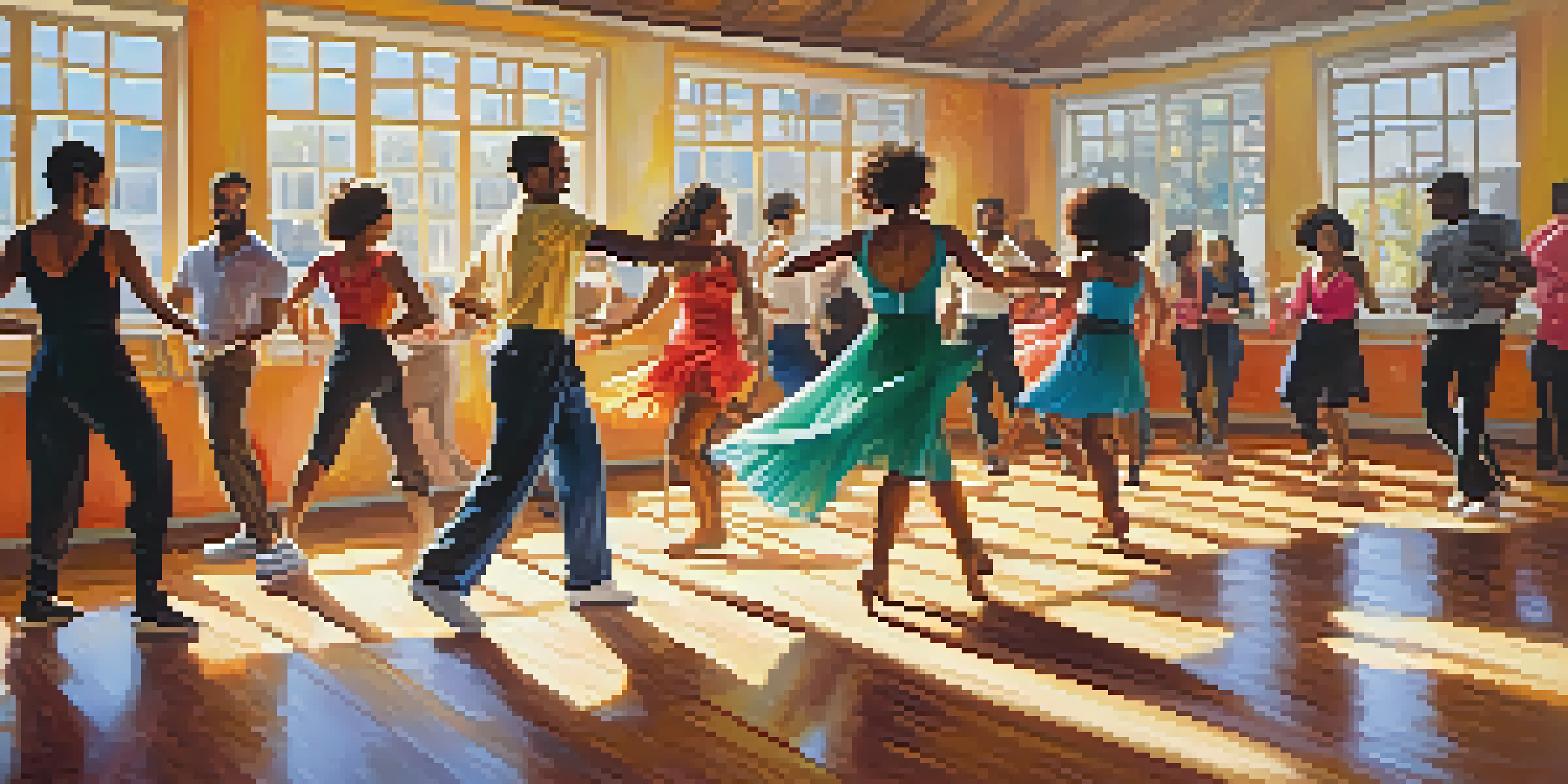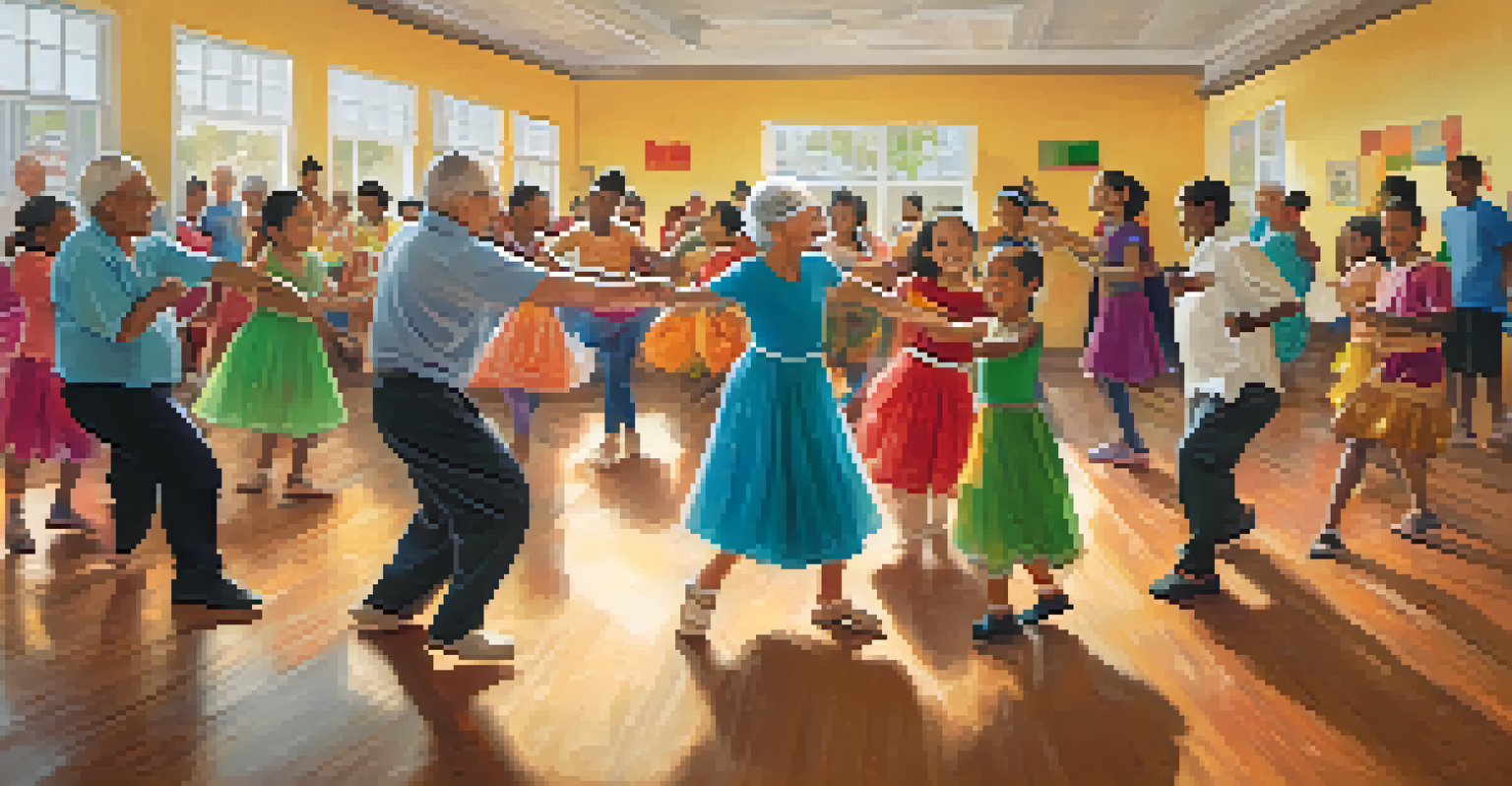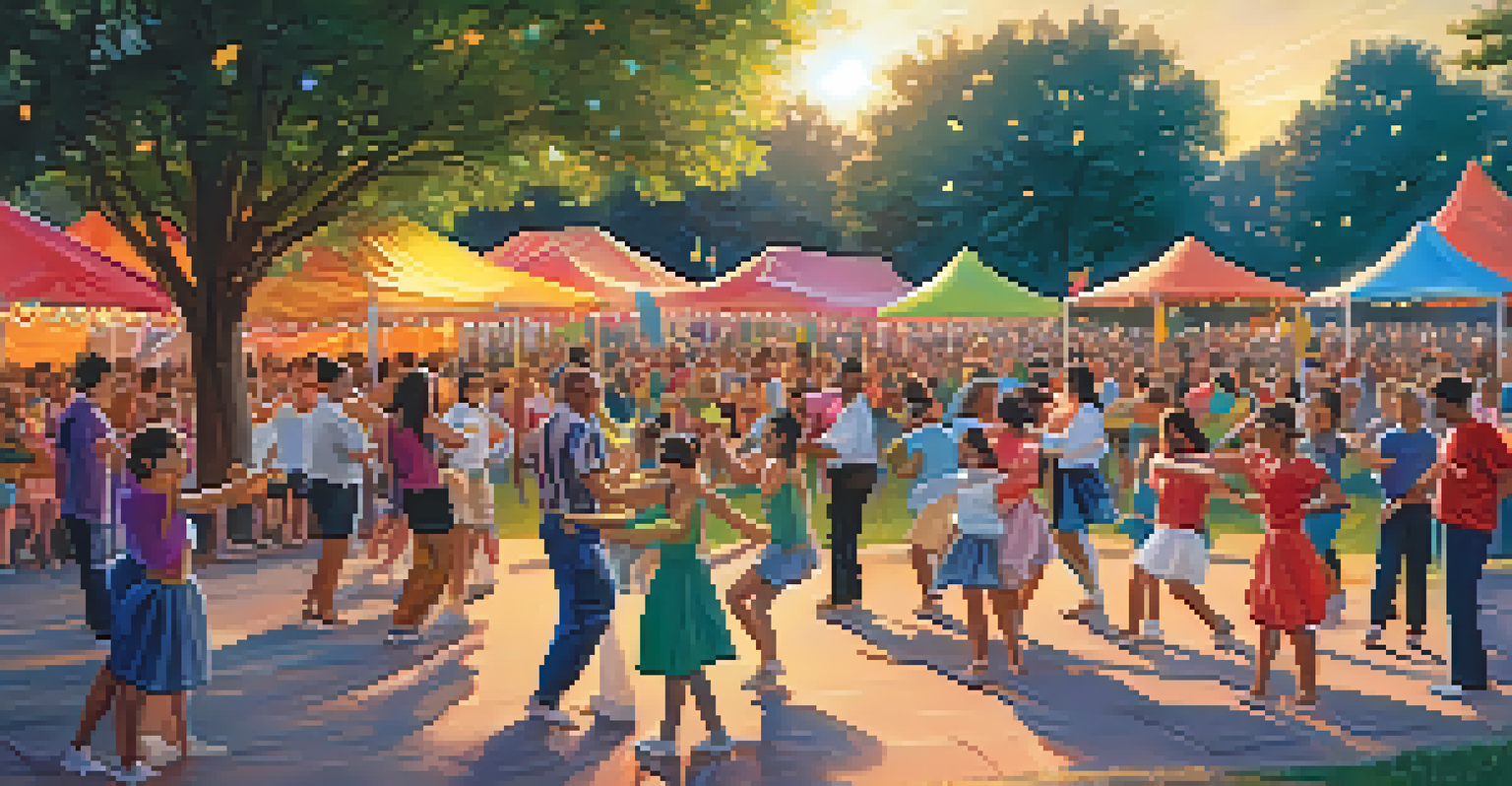The Impact of Dance on Social Connectivity and Relationships

Dance as a Universal Language of Connection
Dance transcends cultural boundaries, acting as a universal language that connects people across different backgrounds. When individuals engage in dance, they communicate emotions and stories that words often fail to express. This shared experience fosters an immediate bond, making it easier for people to connect on a deeper level.
Dance is the hidden language of the soul.
For instance, consider a salsa class where both seasoned dancers and beginners come together. As they learn the rhythm and movements, they not only share laughter and challenges but also build camaraderie that can evolve into lasting friendships. Such interactions highlight how dance creates a welcoming space for social engagement.
Moreover, dance often brings together diverse groups, encouraging collaboration and understanding. This collective experience can break down social barriers, allowing people to appreciate each other’s differences and similarities, thus strengthening social ties.
Building Trust and Teamwork Through Dance
Dance requires a level of trust and cooperation, particularly in partner or group routines. When dancers work together, they must rely on one another to execute movements harmoniously, which naturally fosters teamwork. This collaborative effort can enhance relationships, both on the dance floor and in everyday life.

For example, in a contemporary dance group, members must communicate non-verbally, tuning into each other's movements and emotions. This kind of interaction not only builds trust but also encourages participants to support one another, reinforcing their bonds. The shared goal of creating a beautiful performance can lead to strong friendships.
Dance Unites Diverse Communities
Through shared experiences in dance, individuals from different backgrounds can connect, fostering camaraderie and understanding.
As participants learn to rely on each other, they often carry these lessons into other aspects of life. The skills gained through dance—such as empathy, patience, and communication—can translate into more effective teamwork in professional and personal relationships.
Dance as a Tool for Emotional Expression and Healing
Engaging in dance can be a powerful outlet for emotional expression, providing individuals a way to channel their feelings creatively. This expressive quality of dance can serve as a form of therapy, helping people process emotions and connect with others who share similar experiences. Through movement, participants can experience a sense of liberation and connection.
Dancing is like dreaming with your feet!
For instance, dance therapy sessions often encourage individuals to express grief, joy, or anxiety through movement. Participants find solace in the shared experience of expressing their emotions, which can lead to deeper connections with others in the group. This shared vulnerability often results in supportive relationships formed through mutual understanding.
Moreover, as individuals dance together and share their stories, they develop empathy towards one another. This emotional connection can strengthen social bonds, as participants feel seen and heard in ways that traditional conversations may not allow.
Enhancing Cultural Awareness Through Dance
Dance is deeply rooted in culture and tradition, and participating in different dance forms can enhance cultural awareness among individuals. When people engage in dance styles from various cultures, they not only learn the movements but also the history and significance behind them. This fosters a greater appreciation for diversity, promoting social cohesion.
Consider a community event featuring traditional dances from different cultures. Participants experience not only the joy of dancing but also the stories and meanings behind each movement. This shared cultural experience can ignite curiosity and create conversations, allowing individuals to bond over learning and exploration.
Trust and Teamwork Through Movement
Engaging in dance requires collaboration, enhancing trust and teamwork among participants both on and off the dance floor.
As people become more culturally aware through dance, they often find common ground with others, fostering relationships built on respect and understanding. In this way, dance acts as a bridge that connects communities and nurtures social ties across cultural divides.
The Role of Dance in Community Building
Dance plays a significant role in community building, bringing people together for shared experiences that strengthen social networks. Community dance events, such as festivals or workshops, create opportunities for individuals to interact and bond over a common passion. These gatherings foster a sense of belonging, which is essential for cultivating relationships.
For example, a local dance festival may invite people of all ages and backgrounds to participate, fostering an inclusive environment. Attendees can meet new friends, exchange ideas, and form connections that extend beyond the dance floor. This sense of community can be especially vital in urban areas, where social isolation is prevalent.
As community members engage in dance together, they create lasting memories that contribute to a collective identity. This shared experience can lead to increased support for one another, ultimately strengthening the fabric of the community.
Dance as a Medium for Intergenerational Connection
Dance serves as a powerful medium for bridging generational gaps, allowing individuals from different age groups to connect and share experiences. Whether through family gatherings, community events, or dance classes, people of all ages can find joy and connection in movement. This intergenerational interaction enriches relationships and fosters mutual understanding.
For instance, a family may participate in a traditional dance together, where grandparents share their knowledge with younger generations. As they learn and perform together, they create cherished memories that strengthen family bonds. This exchange of knowledge and experience can lead to deeper appreciation and respect across generations.
Dance as Emotional Expression
Dance provides a powerful outlet for emotional expression, allowing individuals to process their feelings and connect with others.
Moreover, engaging in dance allows younger individuals to learn from the wisdom of their elders, while older generations can experience the energy and creativity of youth. This reciprocal relationship nurtures connections that can last a lifetime, promoting a sense of unity within families and communities.
The Transformative Power of Dance in Relationships
The act of dancing together can transform relationships, enhancing intimacy and connection between partners, friends, or family members. Dance encourages physical closeness and shared experiences, which can strengthen emotional bonds. As individuals move in sync, they often find themselves more in tune with each other’s feelings and desires.
For example, couples who take dance classes together often report improved communication and understanding in their relationship. The shared effort of learning new steps and routines helps them navigate challenges together, reinforcing their partnership. This endeavor can lead to a more profound appreciation for one another.

Additionally, as friends or family members engage in dance, they create joyful memories that contribute to the relationship's foundation. These experiences can be a source of comfort and support during difficult times, illustrating how dance can be a transformative force in nurturing and strengthening bonds.
Conclusion: The Lasting Impact of Dance on Social Connectivity
In conclusion, the impact of dance on social connectivity and relationships is profound and multifaceted. From fostering trust and teamwork to enhancing emotional expression and cultural awareness, dance serves as a powerful tool for building connections. Its ability to bring people together in shared experiences creates lasting bonds that enrich our lives.
As we reflect on the role of dance, it's clear that it not only entertains but also transforms communities and personal relationships. Whether through a dance class, a community event, or simply dancing with friends, the opportunities for connection are endless.
So, the next time you find yourself on the dance floor or at a community event, remember the potential for connection that lies within every step. Embrace the rhythm, share the joy, and watch as dance weaves its magic, enriching your relationships and social life.